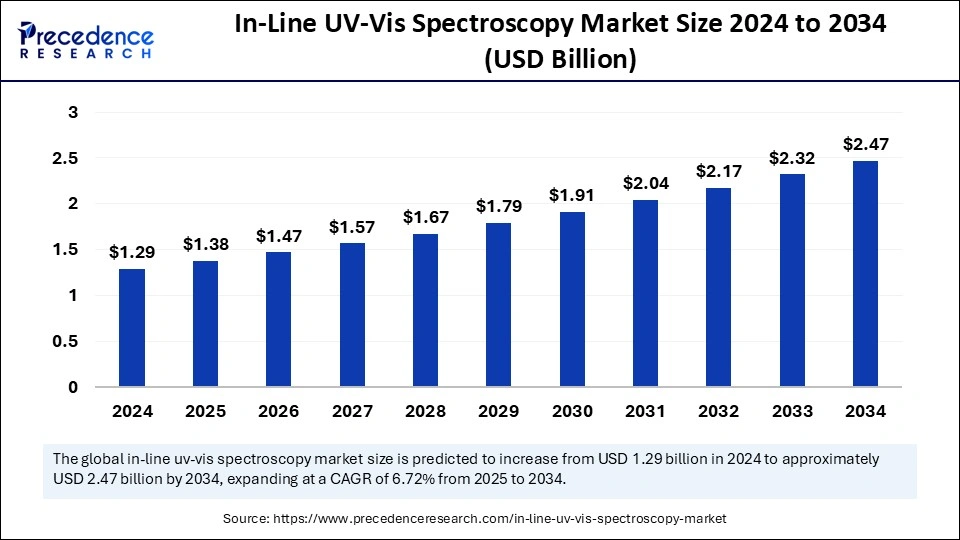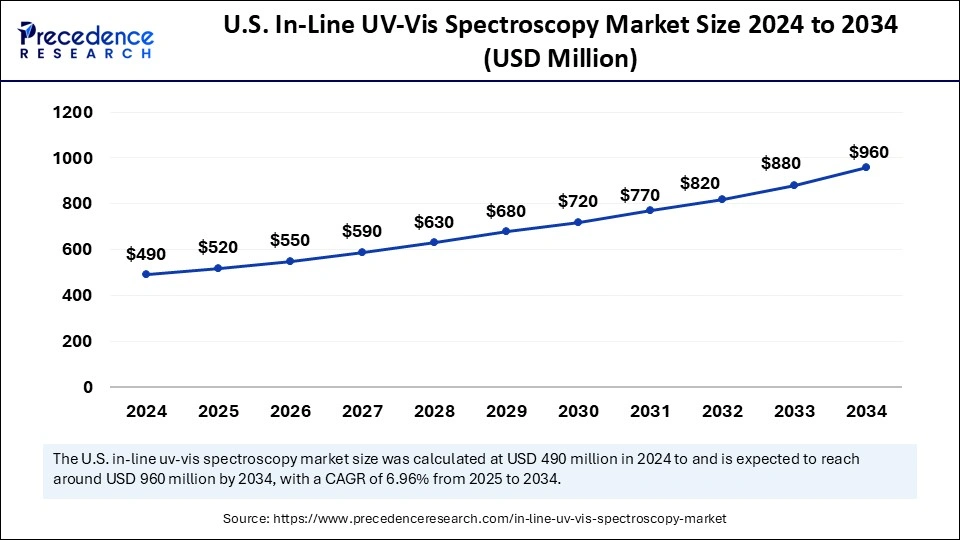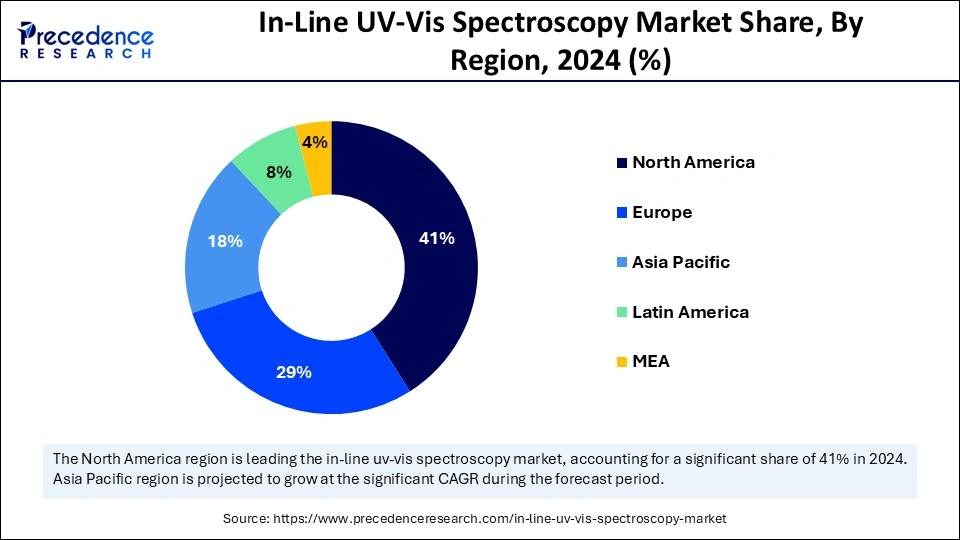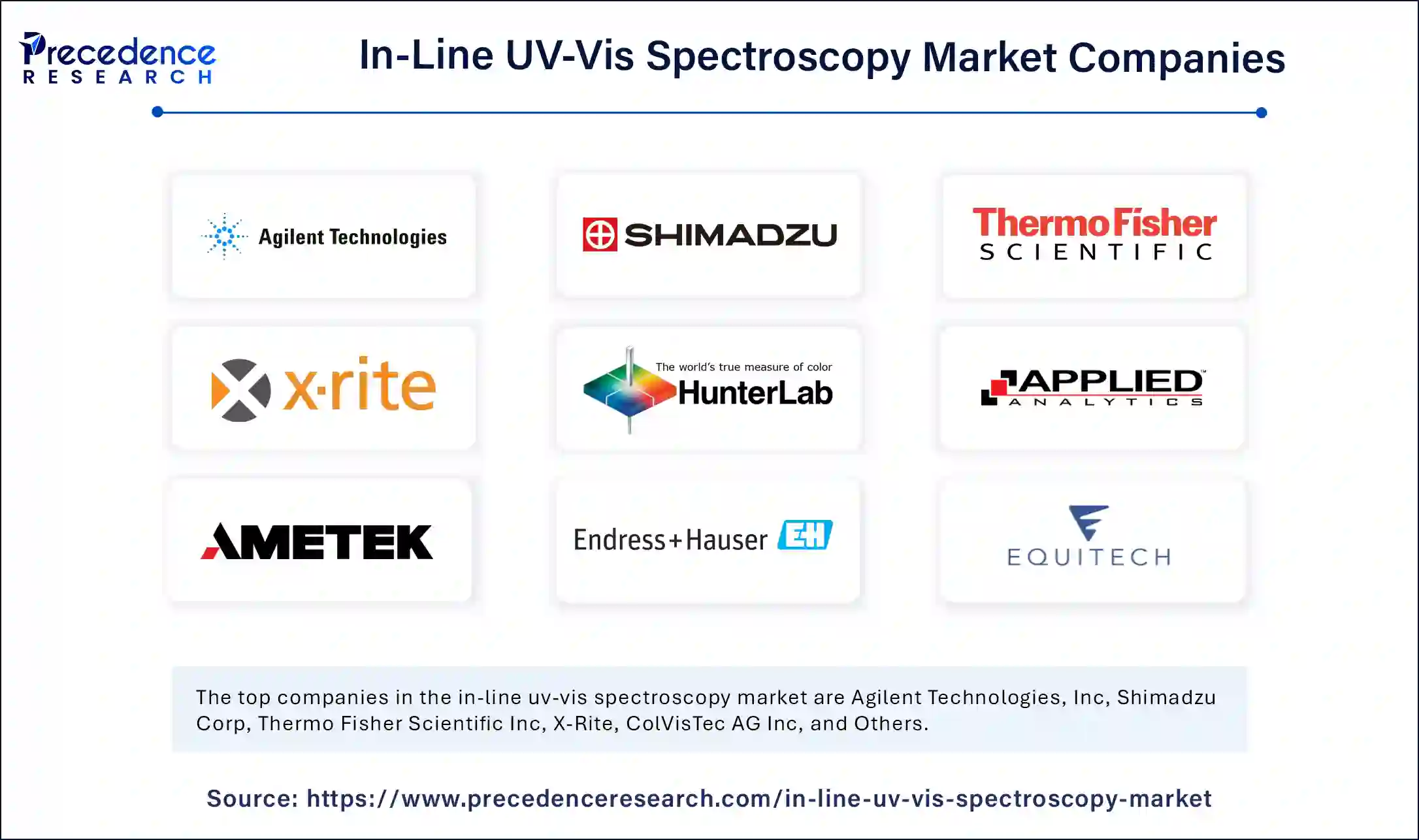November 2024
The global in-line UV-vis spectroscopy market size is calculated at USD 1.38 billion in 2025 and is forecasted to reach around USD 2.47 billion by 2034, accelerating at a CAGR of 6.72% from 2025 to 2034. The North America market size surpassed USD 530 million in 2024 and is expanding at a CAGR of 6.87% during the forecast period. The market sizing and forecasts are revenue-based (USD Million/Billion), with 2024 as the base year.
The global in-line UV-vis spectroscopy market size accounted for USD 1.29 billion in 2024 and is predicted to increase from USD 1.38 billion in 2025 to approximately USD 2.47 billion by 2034, expanding at a CAGR of 6.72% from 2025 to 2034. The market is increasing due to growing concerns about environmental issues that need to be addressed, as well as the need to meet safety regulations in the food and beverage industry, along with monitoring and testing processes in several industries, driving the market further on a global scale.

AI has been revolutionizing the in-line UV-vis spectroscopy market by presenting chemometrics as an AI-based process with machine learning and deep learning. In fact, to enhance the precision and efficiency of spectroscopy, the integration of machine learning algorithms to image processing techniques has emerged as a strong approach in the market. Artificial intelligence methods are precise at recognizing the patterns in datasets, thus improving the understanding of data.
AI offers improved insights into the various processes, characteristics, and interactions of sample analysis data. One of the most powerful techniques is polynomial regression, which is beneficial for precise data analysis. AI has been increasingly used in the application of analytical chemistry to create compounds with innovative approaches and offers various solutions for drug discovery, material design, and organic synthesis.
The U.S. in-line UV-vis spectroscopy market size was exhibited at USD 490 million in 2024 and is projected to be worth around USD 960 million by 2034, growing at a CAGR of 6.96% from 2025 to 2034.

North America accounted for the largest in-line UV-vis spectroscopy market share in 2024. The market is proliferating in the region due to the strong presence of leading players offering online UV-vis spectroscopy equipment, technological advancement in the sector of instrumentation, and the growing need for the analysis of food and beverages for safety purposes, which requires a range of various devices of a precise nature. In addition to this, the active presence of the National Institute of Standards and Technology in the U.S., which offers in-detail requirements for spectroscopy for end-users, in turn, helps expand the in-line UV-vis spectroscopy market in the region.
Country-wise, the U.S. is leading the in-line UV-vis spectroscopy market in North America. The growth is attributed to the presence and assertion of key players in the region along with growing awareness of complying with strict regulations for safety standards in several sectors, further expanding the market's reach. The growing use of in-line UV-spectroscopy for quality control is another driving factor for the region. Apart from this, companies based in the U.S. are integrating inline UV-vis spectroscopy equipment with automation systems and data management software, augmenting the market's growth.

Asia Pacific is expected to witness the fastest growth during the foreseeable period. The region is witnessing a significant growth rate owing to the substantial growth rate that has been observed in evolving economies like India and China, especially due to the expansion of the painting and pharmaceutical industries. Additionally, increasing instances of adulteration in the food and beverage industry highlight the need for stringent regulations to ensure safety and to comply with safety standards set by authorities.
The in-line UV vis spectroscopy means the application of UV spectroscopy in real-time along with constant monitoring of the samples. This method uses light absorption by molecules to find out their properties and concentration. This technique is useful in various industries, like production processes. Manufacturers can achieve meaningful data about the composition of their products, which is further helpful in quality assurance, process control, and efficiency. The in-line UV-vis spectroscopy market is experiencing a substantial growth rate due to the growing demand for real-time monitoring and quality control in different industries.
The presence of many leading players providing new solutions with passing days strengthens the market globally. However, hindering factors like substantial initial investment in using this technique may affect the market negatively to some extent, which needs to be worked on to boost the market's growth further. Geographically, North America and Europe are frontrunners in the market due to the well-settled industries and research institutes. On the other hand, Asia Pacific is anticipated to witness a significant growth rate in the market.
| Report Coverage | Details |
| Market Size by 2034 | USD 2.47 Billion |
| Market Size in 2025 | USD 1.38 Billion |
| Market Size in 2024 | USD 1.29 Billion |
| Market Growth Rate from 2025 to 2034 | CAGR of 6.72% |
| Dominated Region | North America |
| Fastest Growing Market | Asia Pacific |
| Base Year | 2024 |
| Forecast Period | 2025 to 2034 |
| Segments Covered | Application, End-User, and Regions |
| Regions Covered | North America, Europe, Asia-Pacific, Latin America and Middle East & Africa |
Growing use of UV and visible spectroscopy in the pharma and biotech companies
The major growing factor for the in-line UV-vis spectroscopy market is the increasing use of ultraviolet and visible spectroscopy for process optimization in different sectors like pharmaceuticals, food & beverages, and biotechnology, augmenting the market's growth. The use of UV-vis spectroscopy as an analytical tool has become a popular method as such techniques are able to deliver high throughput screening, micro-volume sampling and allow software integration with instruments, making it more demanding on the global stage. With the help of these advanced systems, they can be collected at a large number of points, recorded efficiently, and shared using these techniques, which are immensely beneficial for research and development, further expanding the market's growth.
Growing focus on quality assurance
A growing focus on quality assurance in various industries is another key driving factor for the market. Consumers and regulatory authorities prefer safe and higher-quality products. Thus, manufacturers are looking for a solution that can comply with stringent regulations of quality control. The in-line UV-vis spectroscopy method shows a promising approach to ensuring the quality of the products. Maintaining high quality standards strengthens the brand's reliability, thus expanding the market's reach on a global level.
Complex sampling circumstances and a less skilled workforce
The major restraining factors for the in-line UV-vis spectroscopy market include a lack of a skilled workforce and complicated environments from where samples need to be collected and stored, creating barriers to market growth. Industries like mining and pharmaceuticals have a sampling collection process that is harsher than usual, owing to high pressure, temperature differences, and the possibility of corrosion. Adopting such a challenging situation requires customized equipment and materials, which further add cost and complexity to the implementation of such techniques.
Moreover, significant upfront investment is required to implement an in-line UV-vis spectroscopy technique. It needs spectrometers, sensors, and integration of technologies to establish equipment methods. The lack of a skilled workforce who are able to maintain the equipment and its efficiency, calibrate and maintain data, and resolve on-site technical issues is again a challenging task posing further challenges to the market's growth.
Integration with industry 4.0
The major opportunity of inline UV-vis spectroscopy is the integration of cutting-edge technologies with spectroscopy techniques, augmenting the market's growth by creating lucrative opportunities in the global market. The incorporation of AI and IoT can revolutionize real-time process optimization and predictive maintenance. With the help of data analytics and machine learning algorithms, operational efficiency and product quality can be increased to their peak. Continuous advancements in spectroscopy features like miniaturization, portability, and easy integration can be game changers as they are applicable to diverse industries and fulfill their evolving needs.
The color instrument segment dominated the global in-line UV-vis spectroscopy market in 2024. The segment is expanding due to its extensive applications in different sectors like the food & beverage industry, paint, and pharmaceuticals, along with increasing investment by the leading players for the launch of in-line colour measurement solutions. In the production process, to evaluate the quality of colour values, colour measurement is a majorly adopted method by businesses, leading to the segment's further growth. While assessing product quality in offline measurement mode, challenges like in–time intervention have been noticed that can be addressed with this solution, further expanding the market's reach.
The chemical concentration segment is expected to witness the fastest growth during the foreseeable period. Identifying molecular structure and its response to different circumstances is a major driving factor for the segment. In the chemical industry, safety and reliability are top priorities as chemicals can easily interact with environmental conditions and, thus, they are volatile in nature, which needs to be addressed while dealing with various chemicals before the launch of any product. Moreover, the segment is expanding due to in-line UV-vis spectroscopy found many applications in bioanalysis, clinical analysis, material and environmental analysis, including forensic science.
The chemical industry segment is accounted for the largest in-line UV-vis spectroscopy market share in 2024. The growth of this segment is attributed to the growth due to the expansion of chemical industries across the globe. In-line monitoring of wet chemical methods encompasses monitoring alkaline and acidic texturing, hydrofluoric acid, nitric acid and hydrogen peroxide, etc. The growing use of in-line UV spectroscopy for monitoring these parameters is further fueling the segments' growth. Moreover, the presence of leading players who provide instantaneous in-line measurement of gas and liquid concentration in the chemical sector is a key driving factor for the market's growth.
The painting and coating segment is expected to grow rapidly during the foreseeable period. The segment is expanding rapidly due to the increasing adoption of in-line UV-vis spectroscopy in painting, and the coating sector is the key driving factor. In-line UV-vis spectroscopy offers to measure manufactured substances on a regular interval of fixed time, like 10 seconds or less, directly while processing, which does not require sampling and interruption in the production line.

By Application
By End-User
By Geography
For inquiries regarding discounts, bulk purchases, or customization requests, please contact us at sales@precedenceresearch.com
No cookie-cutter, only authentic analysis – take the 1st step to become a Precedence Research client
November 2024
March 2024
June 2024
March 2025